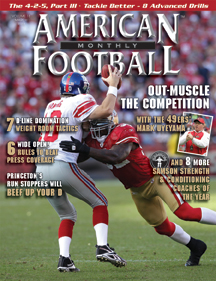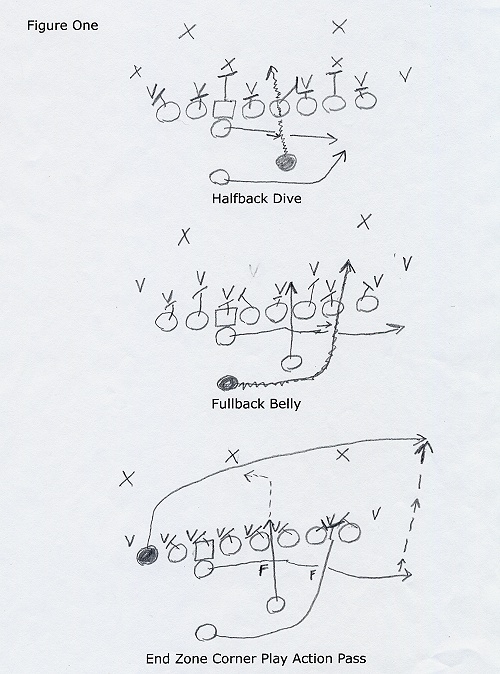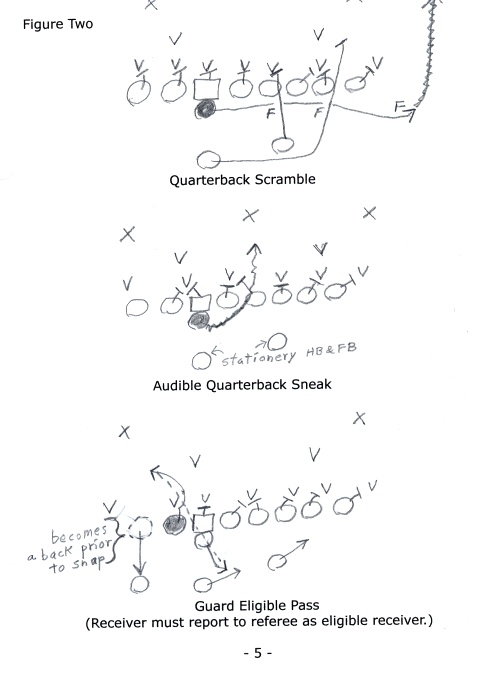Article CategoriesAFM Magazine
|
One More Trick Play Seriesby: Glenn G. DahlemRetired Coach © More from this issue Many times at the scholastic level, an offense that has been moving the ball will suddenly find itself stopped inside the red zone. This often happens when an opponent has slightly larger linemen and linebackers. The offensive linemen then become more tightly packed in a goal line or short yardage defense. There is a trick play series that could alleviate this situation, especially if it hasn’t been well scouted in advance. For many years, the basic offensive alignment of seven linemen and four backs has been the norm. In fact, if a team lines up with five backs and only six linemen, a penalty is the result. However, if the reverse is true and a team sets up with eight linemen and three backs, it is considered legal. Why would a coach want to do this? The answer is to surprise the opponent. This trick play series is perfect for a high scho0ol offense that continues to struggle in the red zone. This article describes two running plays and a pass, intended for initial use when the 8-3 unbalanced offense is used in a game situation. They include the halfback dive, fullback belly and the end zone corner pass (Diagram 1). When the surprise value of the play is gone, three other plays can be used – the quarterback scramble, quarterback sneak, and a guard-eligible pass (Diagram 2).
The 8-3 unbalanced formation is best used inside an opponent’s 10-yard line or in a short yardage situation. After breaking the huddle, either a third tackle has been substituted for a back or one of the backs sets up in the line using the same stance as the other linemen. In addition, a conventional unbalanced line is used with an end and guard to the left of center with the other linemen on the right. This confronts the defensive line with two ‘extra’ positions to cover. No matter how the defense adjusts, there will be a hole somewhere in the defense. If the defense plays a gap defense, one gap will not have a defender in it. Since the offensive linemen won’t know where their defensive opponents will line up, blocking is by rule rather than assignment. On running plays, if there is a lineman or linebacker over the offensive lineman, he is blocked. If not, ask your players to use their best judgment whether blocking a defensive back or joining your teammate closest to the hole for a double team. If the defense is in a gap defense, block the opponent to the left. If no one is in that gap, join your teammate on the right for a double team. On pass plays, block as for a run but be sure not to go past the line of scrimmage. The 8-3 unbalanced formation is not intended to be a team’s major offensive formation. It relies on both shock and surprise and could probably not be used for a long, sustained offensive drive. The diagrams are intended for an alignment to the right. But the formation can be run to the left – all blocks and assignments are then reversed. This could prove desirable if the offense was starting from the right hash mark or has a left handed quarterback. |
|
| HOME |
MAGAZINE |
SUBSCRIBE | ONLINE COLUMNISTS | COACHING VIDEOS |
Copyright 2024, AmericanFootballMonthly.com
All Rights Reserved






